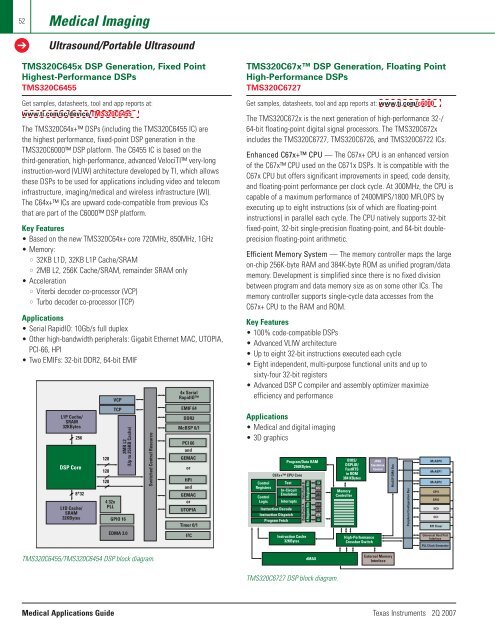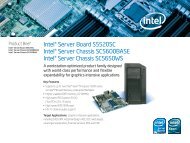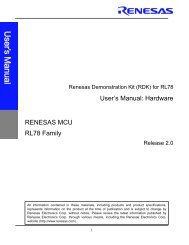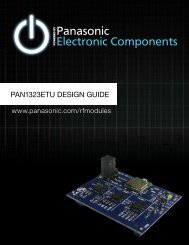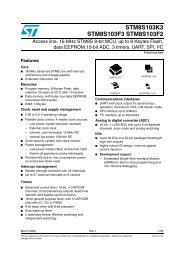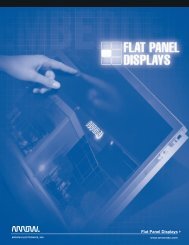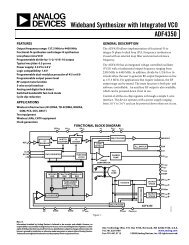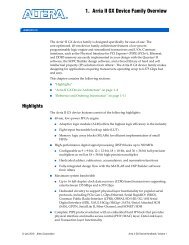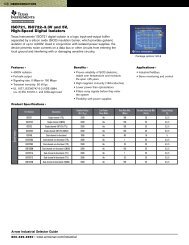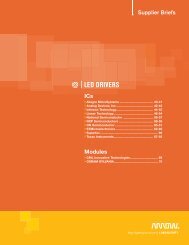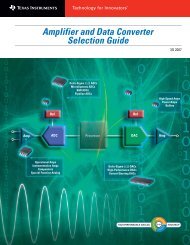52➔<strong>Medical</strong> ImagingUltrasound/Portable UltrasoundTMS320C645x DSP Generation, Fixed PointHighest-Performance DSPsTMS320C6455Get samples, datasheets, tool and app reports at:www.ti.com/sc/device/TMS320C6455The TMS320C64x+ DSPs (including the TMS320C6455 IC) arethe highest performance, fixed-point DSP generation in theTMS320C6000 DSP platform. The C6455 IC is based on thethird-generation, high-performance, advanced VelociTI very-longinstruction-word (VLIW) architecture developed by TI, which allowsthese DSPs to be used for applications including video and telecominfrastructure, imaging/medical and wireless infrastructure (WI).The C64x+ ICs are upward code-compatible from previous ICsthat are part of the C6000 DSP platform.Key Features• Based on the new TMS320C64x+ core 720MHz, 850MHz, 1GHz• Memory:• 32KB L1D, 32KB L1P Cache/SRAM• 2MB L2, 256K Cache/SRAM, remainder SRAM only• Acceleration• Viterbi decoder co-processor (VCP)• Turbo decoder co-processor (TCP)<strong>Applications</strong>• Serial RapidIO: 10Gb/s full duplex• Other high-bandwidth peripherals: Gigabit Ethernet MAC, UTOPIA,PCI-66, HPI• Two EMIFs: 32-bit DDR2, 64-bit EMIFL1P Cache/SRAM32KBytes256DSP Core8*32L1D Cache/SRAM32KBytes1281281284 32xPLLVCPTCPGPIO 162MB L2(Up to 256KB Cache)EDMA 3.0Switched Central Resource4x SerialRapidIOEMIF 64DDR2McBSP 0/1PCI 66andGEMACorHPIandGEMACorUTOPIATimer 0/1I2CTMS320C67x DSP Generation, Floating PointHigh-Performance DSPsTMS320C6727Get samples, datasheets, tool and app reports at: www.ti.com/c6000The TMS320C672x is the next generation of high-performance 32-/64-bit floating-point digital signal processors. The TMS320C672xincludes the TMS320C6727, TMS320C6726, and TMS320C6722 ICs.Enhanced C67x+ CPU — The C67x+ CPU is an enhanced versionof the C67x CPU used on the C671x DSPs. It is compatible with theC67x CPU but offers significant improvements in speed, code density,and floating-point performance per clock cycle. At 300MHz, the CPU iscapable of a maximum performance of 2400MIPS/1800 MFLOPS byexecuting up to eight instructions (six of which are floating-pointinstructions) in parallel each cycle. The CPU natively supports 32-bitfixed-point, 32-bit single-precision floating-point, and 64-bit doubleprecisionfloating-point arithmetic.Efficient Memory System — The memory controller maps the largeon-chip 256K-byte RAM and 384K-byte ROM as unified program/datamemory. Development is simplified since there is no fixed divisionbetween program and data memory size as on some other ICs. Thememory controller supports single-cycle data accesses from theC67x+ CPU to the RAM and ROM.Key Features• 100% code-compatible DSPs• Advanced VLIW architecture• Up to eight 32-bit instructions executed each cycle• Eight independent, multi-purpose functional units and up tosixty-four 32-bit registers• Advanced DSP C compiler and assembly optimizer maximizeefficiency and performance<strong>Applications</strong>• <strong>Medical</strong> and digital imaging• 3D graphicsControlRegistersControlLogicProgram/Data RAM256KBytesC67x+ CPU CoreTestIn-CircuitEmulationInterruptsInstruction DecodeInstruction DispatchProgram FetchData Patch A Data Patch BInstruction Cache32KBytesA Register File B Register FileD2 M2 S2 L2L1 S1 M1 D1BIOS/DSPLIB/FastRTSin ROM384 KBytesMemoryControllerHigh-PerformanceCrossbar SwitchJTAGEmulationControlMcASP DMA BusPeripheral Configuration BusMcASP0McASP1McASP2SPI1SPIOIIC0IIC1RTI TimerUniversal Host PortInterfacePLL Clock GeneratorTMS320C6455/TMS320C6454 DSP block diagram.dMAXExternal MemoryInterfaceTMS320C6727 DSP block diagram.<strong>Medical</strong> <strong>Applications</strong> <strong>Guide</strong> Texas Instruments 2Q 2007
<strong>Medical</strong> ImagingComponent Recommendations for Ultrasound/Portable Ultrasound53➔Component RecommendationsComponent Description Key Features Benefits Other TI SolutionsAmplifiersOPA695 High-Speed Op Amp G = +2 BW 1400MHz, G = +8 BW 450MHz, 4300V/µs SR Ultra-wideband, current feedbackOPA832 Video Buffer Op Amp G = +2 BW 80MHz, 3.9mA supply, 350V/µs SR Low power, fixed gainOPA847 VFB Op Amp 3.9GHz GBW, 0.85nV/ Hz noise, 950V/µs SR High DC accuracy, stable for gains >12V/VOPA861 Transconductance Amp 80MHz, open-loop, G = +5 BW, 900V/µs SR 95mA/V high transconductance, 5.4mA I QTHS4131 High-Speed Op Amp 150MHz (–3dB) BW, 51V/µs SR, –100dB THD Differential input/differential output THS4120, THS4150THS4304 High-Speed Op Amp 3GHz BW, 830V/µs SR, 2.4nV/ Hz noise, 7.5ns High bandwidth and fast settling timesettling time (001%)THS4509 High-Speed Op Amp 1900MHz BW, 6600V/µs SR, 2ns settling time (1%) Low distortion, fully differential THS4508, THS4511VCA2615 Dual, Low-Noise LNA Very low-noise: 0.7nV/ Hz For high-end systems requiring high dynamic range VCA2611and VCAand flexibilityVCA2617 Dual, Low-Power VCA Differential I/O VCA, low power: 52mW/ch Low-power, low-noise VCA to follow an off-chip LNA VCA2614VCA8613 8-Channel Complete with LNA, VCA and LPF; lowest power: 75mW/ch, PGA output feeds directly into an integrated 2-pole,Ultrasound Front-End 3V supply low-pass filter, allowing for direct ADC connectionVCA8617 8-Channel Complete with LNA, VCA and LPF; low noise of 1.0nV/ Hz PGA output feeds directly into integrated low-pass filterUltrasound Front-EndData ConvertersADS1610 Delta-Sigma ADC 16-bit, 10MSPS, parallel interface SYNC pin for simultaneous samplingADS1605 Delta-Sigma ADC 16-bit, 5MSPS (10MSPS in 2x mode), 88dB SNR, –99dB THD Selectable on-chip referenceADS5121 High-Speed ADC 8-channel, 10-bit, 40MSPS, 1.8V analog/digital supply Low power, individual channel power down ADS5122ADS5232 High-Speed ADC Dual 12-bit, 65MSPS, 3.3V analog/digital supply Internal or external referenceADS5240 High-Speed ADC 4-channel, 12-bit, 65MSPS, 3.3V analog/digital supply Serialzed LVDS outputs, integrated frame and ADS5242bit patternsADS5272 High-Speed ADC 8-channel, 12-bit, 65MSPS, 3.3V analog/digital supply Serialized LVDS outputs, integrated frame and ADS5271/72/73/77bit patternsADS7809 AR ADC 16-bit, 100kHz sample rate, 86dN SINAD with 20kHz input, Output sync pulse for ease of use with standard DSPserial ouputprocessorsADS8380 SAR ADC 18-bit, 600kHz sample rate, ±2LSB (typ), pseudo-differential Zero latency, serial interface with clock up to 40MHzinputDAC2900 High-Speed DAC 10-bit, 125MSPS dual DAC Supports 3.3/5V DAC2902, DAC2904DAC5652 High-Speed DAC 10-bit, 275MSPS dual DAC High sample rate with low power DAC5662, DAC5672DAC7615 V OUT DAC Quad, serial input, 12-bit, 20mW low power Unipolar or bipolar operation, double-buffered inputs DAC7714, DAC7554DAC8560 V OUT DAC 16-bit, 0.15nV-s glitch, ±10µs to 0.003% FSR settling time Small package, low power DAC8554, DAC8551, DAC8552DAC8330 Precision DAC 16-bit, V OUT , 1LSB INL Very low power, serial interface DAC8331, DAC8830ReferencesREF31xy Voltage Reference 0.2% voltage accuracy Precise trigger voltage ADC REF32xy, REF33xyREF32xx Low Drift, Bandgap 0.2% (max) accuracy, 7ppm/°C (max) drift, 0.1mA (max) I Q Multiple output voltages, SOT23-6REF33xx microPower Bandgap 0.1% (max) accuracy, 30ppm/°C (max) drift, 0.005mA (max) I Q Multiple output voltages, MSOP-8, SO-8REF50xx Precision Reference 0.05% accuracy, 3ppm/°C (max) drift, 6µV PP low noise Multiple output voltages, SC71ProcessorsTMS320C- DSP 1GHz, SRIO, 2MB RAM High-performance, fixed-point 16-bit processor TMS320C6454BZTZ6455BZTZTMS320 DSP C64x+, ARM9, video accelerators DaVinci digital media processor TMS320DM6437,DM6446BZWTTMS320C6424TMS320C6727 DSP Up to 350MHz, 2100MFLOPS Floating point DSP TMS320C6713, TMS320C6726Preview products are listed in bold blue.New products are listed in bold red.Texas Instruments 2Q 2007<strong>Medical</strong> <strong>Applications</strong> <strong>Guide</strong>
- Page 1 and 2: TMTechnology for InnovatorsMedical
- Page 3 and 4: Consumer and Portable Medical Devic
- Page 6: 6➔Consumer and Portable Medical D
- Page 9 and 10: Consumer and Portable Medical Devic
- Page 11 and 12: Consumer and Portable Medical Devic
- Page 13: Consumer and Portable Medical Devic
- Page 16 and 17: 16➔Consumer and Portable Medical
- Page 18 and 19: 18➔Consumer and Portable Medical
- Page 20 and 21: 20 Diagnostic, Patient Monitoring a
- Page 22 and 23: 22➔Diagnostic, Patient Monitoring
- Page 24 and 25: 24➔Diagnostic, Patient Monitoring
- Page 26 and 27: 26➔Diagnostic, Patient Monitoring
- Page 28 and 29: 28➔Diagnostic, Patient Monitoring
- Page 30 and 31: 30➔Diagnostic, Patient Monitoring
- Page 32 and 33: 32➔Diagnostic, Patient Monitoring
- Page 34 and 35: 34➔Diagnostic, Patient Monitoring
- Page 36 and 37: 36➔Diagnostic, Patient Monitoring
- Page 38 and 39: 38➔Diagnostic, Patient Monitoring
- Page 40 and 41: 40➔Diagnostic, Patient Monitoring
- Page 42 and 43: 42➔Diagnostic, Patient Monitoring
- Page 44 and 45: 44➔Diagnostic, Patient Monitoring
- Page 46 and 47: 46➔Diagnostic, Patient Monitoring
- Page 48 and 49: 48➔Medical ImagingUltrasound/Port
- Page 50 and 51: 50➔Medical ImagingUltrasound/Port
- Page 54 and 55: 54➔Medical ImagingComponent Recom
- Page 56 and 57: 56➔Medical ImagingCT ScannersDual
- Page 58 and 59: 58➔Medical ImagingComponent Recom
- Page 60 and 61: 60➔Medical ImagingMagnetic Resona
- Page 62 and 63: 62➔Medical ImagingMagnetic Resona
- Page 64 and 65: 64➔Medical ImagingComponent Recom
- Page 66 and 67: 66➔Medical ImagingDigital X-Raybl
- Page 68 and 69: 68➔Medical ImagingDigital X-RayLo
- Page 70 and 71: 70➔Medical ImagingPET ScannersPET
- Page 72 and 73: 72➔Medical ImagingComponent Recom
- Page 74 and 75: 74➔Medical ImagingPower Managemen
- Page 76 and 77: 76 Medical Instruments➔Medical In
- Page 78 and 79: 78➔Medical InstrumentsMedical Ins
- Page 80 and 81: 80 Resources➔Enhanced ProductTexa
- Page 82 and 83: 82➔ResourcesTI Design ToolsBelow
- Page 84: TMTechnology for InnovatorsFindProd


